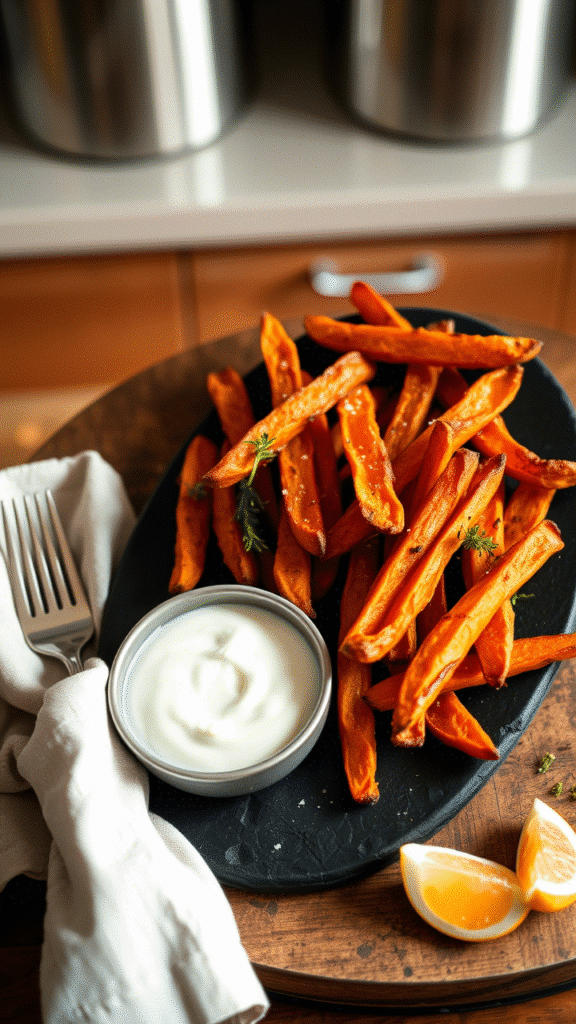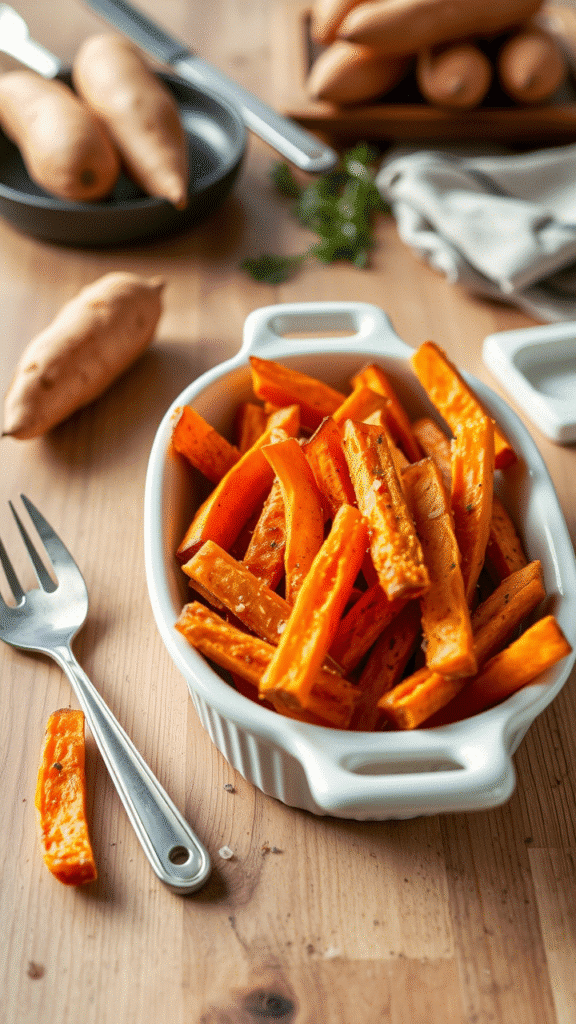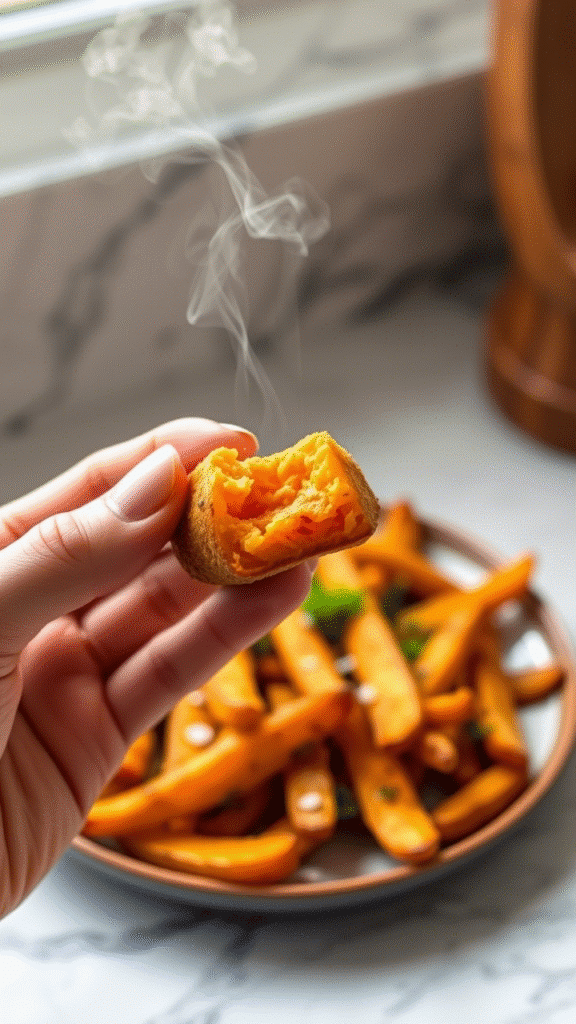Three years ago, I watched a line cook at my restaurant throw yet another batch of soggy sweet potato fries into the trash. The frustration was palpable—we’d gone through six attempts that evening alone. Sweet potatoes seemed determined to mock our efforts, emerging from the oven limp and disappointing while regular potato fries crisped beautifully.
That night changed everything. What followed was months of testing, countless temperature adjustments, and a deep dive into the cellular structure of sweet potatoes that would revolutionize how I approach this deceptively complex side dish.
Sweet potato fries represent one of the most challenging items in modern kitchens. Their higher sugar content and different starch composition create unique obstacles that separate amateur attempts from professional results. The reward, however, is extraordinary—properly executed sweet potato fries deliver a caramelized exterior with concentrated sweetness that elevates any meal.
Understanding Sweet Potato Chemistry
The secret lies in understanding what makes sweet potatoes behave differently than their regular counterparts. Sweet potatoes contain significantly more natural sugars—primarily sucrose, glucose, and fructose—which caramelize at lower temperatures but also retain moisture more aggressively.
Regular potatoes rely on starch conversion for their crispy exterior. Sweet potatoes fight against this process, their cellular structure holding onto water like a sponge that refuses to wring dry. The sugar content, while providing incredible flavor, becomes both blessing and curse in the crisping process.
Professional kitchens that master sweet potato fries understand this fundamental difference. They don’t fight the sweet potato’s nature—they work with it, using techniques that encourage moisture release while protecting those precious sugars from burning.
Ingredients & Substitutions
Primary Ingredients:
- 2-3 large sweet potatoes (approximately 2 pounds)
- 3 tablespoons neutral oil (vegetable, canola, or grapeseed)
- 1 tablespoon cornstarch
- 1 teaspoon kosher salt
- ½ teaspoon freshly ground black pepper
- ½ teaspoon smoked paprika
- ¼ teaspoon garlic powder
Sweet Potato Selection: Choose firm sweet potatoes with smooth, unblemished skin. Avoid specimens with dark spots or soft areas—these indicate sugar conversion has already begun, which will interfere with our controlled crisping process. Orange-fleshed varieties like Beauregard or Centennial work exceptionally well, though purple sweet potatoes offer interesting color variation.
The size matters more than most realize. Uniformly large sweet potatoes ensure consistent cooking times and allow for proper fry dimensions. Small sweet potatoes often result in irregular shapes that crisp unevenly.
Oil Considerations: Neutral oils with high smoke points perform best. Avocado oil works beautifully if budget allows—its exceptionally high smoke point (520°F) provides extra insurance against burning. Olive oil, while flavorful, can become bitter at the high temperatures necessary for proper crisping.
Cornstarch vs. Alternatives: Cornstarch creates the crucial barrier between sweet potato flesh and heat, allowing controlled dehydration. Potato starch works similarly but can be harder to source. Arrowroot powder provides identical results, though it’s typically more expensive. Rice flour offers an interesting alternative—it creates an exceptionally light, almost tempura-like coating.
Seasoning Substitutions: Smoked paprika adds depth without overwhelming sweetness, but regular paprika works fine. Chipotle powder introduces subtle heat and smoke. For Mediterranean variations, try za’atar or sumac. Indian-inspired versions benefit from garam masala or curry powder.
Those following specific diets will find sweet potato fries naturally accommodating. They’re inherently vegan, gluten-free, and paleo-friendly. The cornstarch coating maintains these dietary benefits while delivering professional results.
Step-by-Step Instructions
Preparation Phase: Preheat your oven to 450°F—this temperature provides the aggressive heat necessary for proper crisping without immediate caramelization. Position racks in the upper and lower thirds, allowing for rotation during cooking.
Cut sweet potatoes into uniform ½-inch thick fries. Consistency is crucial here; irregular sizes mean some pieces will burn while others remain undercooked. I prefer slightly thicker cuts than regular potato fries—sweet potatoes shrink more during cooking due to their higher moisture content.
The Critical Soaking Step: Submerge cut fries in cold water for exactly 30 minutes. This step removes excess surface starch and begins the dehydration process. Some chefs skip this, but professional results demand patience. The water should become slightly cloudy—that’s excess starch leaving the sweet potato.
Drain thoroughly and pat completely dry with clean kitchen towels. Any remaining moisture will interfere with oil adhesion and prevent proper crisping. This step cannot be rushed or half-completed.
Coating Application: In a large bowl, toss dried fries with cornstarch until evenly coated. The cornstarch should disappear into a light dusting—visible clumps indicate too much starch or insufficient tossing. Add oil gradually while tossing, ensuring even distribution.
Season immediately after oil application. Salt and spices adhere better to the oil-coated surface and penetrate slightly during cooking. The mixture should smell fragrant and look evenly coated.
Cooking Process: Arrange fries in a single layer on two large sheet pans lined with parchment paper. Overcrowding is the enemy of crispiness—fries need space for air circulation. Better to use three pans than crowd two.
Bake for 15 minutes, then rotate pans and flip each fry individually. This rotation ensures even browning and prevents any hot spots from burning delicate edges. The flipping motion should be quick and decisive—hesitation allows heat to escape.
Continue baking for 10-15 minutes until edges are golden brown and crispy. The internal texture should be creamy while exteriors provide satisfying crunch. Total cooking time varies based on fry thickness and oven characteristics.
Common Mistakes to Avoid: Never skip the soaking step, even when pressed for time. Skipping this fundamental step guarantees disappointing results. Avoid cutting fries too thin—they’ll dehydrate completely and become bitter. Don’t open the oven door frequently; consistent heat is essential for proper crisping.
Temperature management separates amateur from professional results. If your oven runs hot, reduce temperature to 425°F and extend cooking time. If it runs cool, increase to 475°F but watch carefully for burning.
Cooking Techniques & Science
The science behind perfect sweet potato fries involves managing three competing processes: moisture removal, starch conversion, and sugar caramelization. Understanding these interactions allows precise control over the final product.

Moisture Management: Sweet potatoes contain approximately 77% water compared to regular potatoes’ 79%. While this difference seems minimal, sweet potato’s cellular structure retains moisture more tenaciously. The initial soaking and thorough drying combat this natural tendency.
High-temperature roasting creates rapid surface dehydration while maintaining interior moisture. This differential creates the desired textural contrast—crispy exterior, creamy interior. Lower temperatures allow moisture to escape gradually, resulting in uniformly dry, unappetizing fries.
Starch Gelatinization: Sweet potato starch behaves differently than regular potato starch. It gelatinizes at slightly lower temperatures but doesn’t develop the same crispy exterior naturally. The cornstarch coating compensates for this deficiency, creating an artificial barrier that crisps beautifully.
This coating also prevents direct contact between sweet potato sugars and intense heat. Without this protection, sugars caramelize too quickly, creating bitter, burnt flavors before the interior cooks properly.
Caramelization Control: Sweet potato’s natural sugars begin caramelizing around 300°F. Our 450°F oven temperature accelerates this process, creating desirable browning while the cornstarch barrier prevents burning. The timing becomes crucial—too long produces bitter results, too short leaves fries pale and undercooked.
Professional ovens often have steam injection capabilities. Home cooks can approximate this by placing a pan of water on the bottom rack for the first 10 minutes, then removing it. This technique slows initial caramelization while promoting even cooking.
Tool Considerations: Heavy-gauge sheet pans distribute heat more evenly than thin ones. Dark-colored pans absorb heat faster, potentially causing burning—choose light-colored, heavy pans for best results. Parchment paper prevents sticking without adding grease, maintaining the desired texture.
Convection ovens work exceptionally well for sweet potato fries. The circulating air promotes even moisture removal and browning. Reduce temperature by 25°F when using convection settings and watch timing carefully.
Serving & Pairing Suggestions
Immediate Service: Sweet potato fries demand immediate service—they lose crispiness rapidly as residual moisture redistributes. Serve directly from the oven when possible, arranged on warm plates or in lined baskets.

For restaurant service, hold finished fries in a 200°F warming oven for no more than 10 minutes. Any longer compromises texture irreparably. Some establishments use heat lamps, but these tend to dry out the interior while making exteriors soggy.
Presentation Techniques: Arrange fries in loose, casual piles rather than rigid lines. Their irregular shapes look more appealing when allowed to fall naturally. Garnish with fresh herbs like rosemary or thyme—their aromatic oils complement sweet potato’s natural earthiness.
For elevated presentations, serve in individual paper cones or small cast-iron skillets. The rustic appearance suits sweet potato fries’ homestyle character while maintaining temperature longer than regular plates.
Flavor Pairings: Sweet potato fries pair exceptionally well with tangy, acidic accompaniments that cut through their inherent sweetness. Classic aioli works beautifully, as does chipotle mayo or sriracha ketchup. For sophisticated applications, try honey-mustard gastrique or maple-bourbon dipping sauce.
Protein pairings should complement rather than compete with sweet potato’s natural sweetness. Grilled chicken, pork tenderloin, or salmon work exceptionally well. Avoid overly sweet proteins like glazed ham—the combination becomes cloying.
Beverage Considerations: Beer pairings favor hoppy IPAs or crisp pilsners that cleanse the palate between bites. Wine selections benefit from high acidity—Sauvignon Blanc or Pinot Grigio work well. For cocktails, bourbon-based drinks complement sweet potato’s earthy sweetness naturally.
Creative Variations: Truffle oil drizzling just before service creates an luxurious upgrade. Parmesan cheese, added during the final five minutes of cooking, develops a golden crust. For international flavors, try za’atar and lemon zest or curry powder and yogurt sauce.
Loaded sweet potato fries work well for casual dining applications. Top with pulled pork, caramelized onions, and sharp cheddar for a hearty appetizer. Vegetarian versions might feature black beans, avocado, and lime crema.
Advanced Techniques for Professional Kitchens
Pre-Service Preparation: Restaurants can partially cook sweet potato fries during prep periods, then finish them to order. Par-cook for 12 minutes at 425°F, then cool completely. Finish in a 475°F oven for 5-7 minutes when ordered. This technique maintains quality while reducing ticket times.

Flash-freezing par-cooked fries extends their usability. Spread cooled, par-cooked fries on sheet pans and freeze solid, then transfer to storage containers. They keep for up to three months and finish beautifully from frozen.
Seasoning Innovations: Create signature seasonings by blooming spices in neutral oil before tossing with fries. Heat oil to 200°F, add spices, and steep for 30 minutes. Strain out solids and use the infused oil for coating. This technique intensifies flavors while maintaining the crispy coating.
Compound butters offer another professional touch. Mix softened butter with herbs, spices, or citrus zest, then dot over hot fries just before service. The butter melts quickly, creating an rich, flavorful coating.
Troubleshooting Common Issues
Soggy Results: Usually indicates insufficient dehydration or overcrowding. Ensure proper soaking, thorough drying, and adequate spacing. Check oven temperature accuracy—many home ovens run 25-50°F cooler than displayed.
Burnt Exteriors, Raw Interiors: Typically means temperature is too high or fries are cut too thin. Reduce oven temperature by 25°F and extend cooking time. Thicker cuts cook more evenly and provide better textural contrast.
Uneven Browning: Points to improper pan rotation or hot spots in the oven. Rotate pans halfway through cooking and flip fries individually. Consider oven calibration if problems persist across multiple batches.
Lack of Crispiness: Usually results from moisture issues or insufficient cornstarch coating. Ensure complete drying after soaking and even cornstarch distribution. Some sweet potato varieties are naturally more moist—adjust technique accordingly.
The transformation from simple sweet potato to professional-quality fries requires understanding, patience, and attention to detail. Master these fundamentals, and you’ll produce consistently excellent results that elevate any menu or meal.
Frequently Asked Questions?
Q: Can I make sweet potato fries ahead of time for meal prep?
A: While best served immediately, you can prep components in advance. Cut and soak fries up to 24 hours ahead, storing them in water in the refrigerator. Pat dry and season just before cooking. Alternatively, par-cook fries for 12 minutes, cool completely, and refrigerate for up to 3 days. Finish in a 475°F oven for 5-7 minutes when ready to serve.
Q: Why do my sweet potato fries never get as crispy as restaurant versions?
A: Professional results require precise technique. The most common mistakes are skipping the soaking step, insufficient drying, overcrowding the pan, or using the wrong oven temperature. Restaurants also often use specialized equipment like convection ovens and may par-cook fries during prep time. Following the cornstarch coating method and ensuring proper spacing will dramatically improve your results.
Q: Can I use an air fryer instead of the oven?
A: Air fryers work excellently for sweet potato fries and often produce superior crispiness due to intense air circulation. Reduce cooking temperature to 400°F and cook for 12-15 minutes, shaking the basket every 5 minutes. You may need to reduce the oil slightly since air fryers are more efficient at crisping. The cornstarch coating method still applies and will improve results significantly.
Q: How do I prevent sweet potato fries from becoming bitter?
A: Bitterness usually results from overcooking or burning the natural sugars. Use the cornstarch coating to protect against direct heat, monitor cooking carefully, and don’t exceed 450°F in conventional ovens. If your oven runs hot, reduce temperature to 425°F and extend cooking time. Also ensure you’re not cutting fries too thin, as they’ll dehydrate completely and develop bitter flavors.
Q: What’s the best sweet potato variety for making fries?
A: Orange-fleshed varieties like Beauregard, Centennial, or Jewel work best for fries. They have the ideal balance of moisture, sweetness, and starch content. Avoid very soft varieties like Japanese sweet potatoes, which can become mushy. Purple sweet potatoes work well too and offer visual interest, though they may require slightly longer cooking times. Choose firm, uniformly sized sweet potatoes without soft spots or excessive scarring.

Veronica is a passionate food enthusiast with over three years of experience in exploring and writing about diverse cuisines. Her expertise lies in reviewing restaurants, sharing creative recipes, and discovering the latest food trends. As the voice behind FoodieRecap.com, Anju brings fresh perspectives and culinary insights to her audience.
